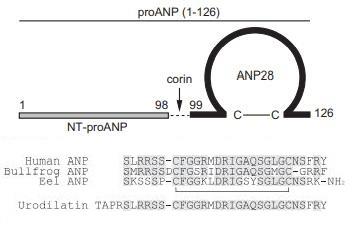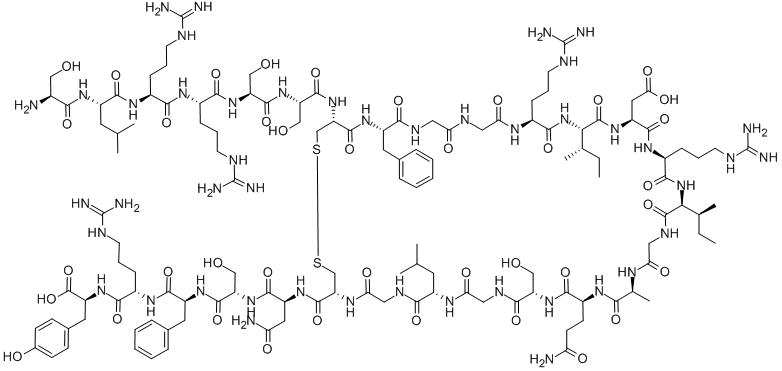ATRIAL NATRIURETIC FACTOR (1-28) (RAT)
- CAS No.
- 88898-17-3
- Chemical Name:
- ATRIAL NATRIURETIC FACTOR (1-28) (RAT)
- Synonyms
- RANF;RANP;ANF 1-28;ALPHA-RANP;ANP-(1-28);RANF (1-28);CARDIONATRIN;ANP 1-28, RAT;ANF (1-28), RAT;α-atriopeptin, rat
- CBNumber:
- CB3670516
- Molecular Formula:
- C128H205N45O39S2
- Molecular Weight:
- 3062.41
- MDL Number:
- MFCD00076228
- MOL File:
- 88898-17-3.mol
| Density | 1.54±0.1 g/cm3(Predicted) |
|---|---|
| storage temp. | -20°C |
| solubility | 0.05 M acetic acid: 1 mg/mL, clear, colorless |
| form | Solid |
| color | White to off-white |
| Water Solubility | Soluble to 1 mg/ml in water |
| Sequence | H-Ser-Leu-Arg-Arg-Ser-Ser-Cys-Phe-Gly-Gly-Arg-Ile-Asp-Arg-Ile-Gly-Ala-Gln-Ser-Gly-Leu-Gly-Cys-Asn-Ser-Phe-Arg-Tyr-OH(Disulfide bridge: Cys7-Cys23) |
| EWG's Food Scores | 1 |
ATRIAL NATRIURETIC FACTOR (1-28) (RAT) price More Price(39)
| Manufacturer | Product number | Product description | CAS number | Packaging | Price | Updated | Buy |
|---|---|---|---|---|---|---|---|
| Sigma-Aldrich | A8208 | Atrial Natriuretic Peptide rat ≥97% (HPLC) | 88898-17-3 | 0.1mg | $107.4 | 2024-03-01 | Buy |
| Sigma-Aldrich | A8208 | Atrial Natriuretic Peptide rat ≥97% (HPLC) | 88898-17-3 | 0.5mg | $611 | 2024-03-01 | Buy |
| Usbiological | A4151 | Atrial Natriuretic Peptide | 88898-17-3 | 1mg | $635 | 2021-12-16 | Buy |
| Usbiological | 517026 | Atrial Natriuretic Peptide | 88898-17-3 | 96Tests | $879 | 2021-12-16 | Buy |
| Usbiological | 517028 | Atrial Natriuretic Peptide | 88898-17-3 | 96Tests | $922 | 2021-12-16 | Buy |
ATRIAL NATRIURETIC FACTOR (1-28) (RAT) Chemical Properties,Uses,Production
Properties
The Mr of human ANP is 3082 and the isoelectric point is about 10.7. It is freely soluble in water, ethanol, and 70% acetone, and insoluble in acetone, benzene, chloroform, and ether. ANP solution in water at >10-4M is stable for more than a year at -20°C.
Gene, mRNA, and precursor
The human ANP gene (NPPA), located on chromosome 1 (1p36.22), consists of three exons, and has AP-1, GRE, and other regulatory elements in the promoter region. Human ANP mRNA is 855 bp long (456bp coding sequence). Nppa first appeared in early bony fish by tandem duplication of the CNP3 gene (Nppc3). The gene structure and its mRNA size are well conserved among teleosts, amphibians, and mammals. Human proANP1–126 is cleaved into ANP-28 (ANP99–126) and N-terminal (NT)-proANP1–98 by the prohormone convertase, corin. ANP mRNA is detected most abundantly in the atrium. Some transcripts are found in the cardiac ventricle, brain, kidney, adrenal, lung, gonads, and lymphoid tissues in mammals. In nonmammals, the heart (atrium) is the main tissue of ANP synthesis followed by the brain, kidney, and interrenal in frogs and teleost fish.
Synthesis and release
Atrial ANP synthesis and release are stimulated principally by atrial stretch (increased blood volume) in mammals. Corticosteroids, α-adrenergic stimulation, and hypoxia also stimulate the gene expression as inferred by the presence of such responsive elements in the human gene. Increased ANP secretion in patients with congestive and ischemic heart failure is related to the atrial stretch and hypoxia, respectively. In eels, ANP release is increased more profoundly by osmotic stimulus than volemic stimulus, but the latter is a major stimulus in trout as in mammals. The regulation of ANP gene (Nppa) expression and release has not been examined in noncardiac tissues yet.
Receptors
ANP binds to the A-type natriuretic peptide receptor (NPR-A or GC-A) with high affinity (Kd=2–3 nM). NPR-A is a single-chain receptor with an extracellular ligand-binding domain, a membrane-spanning domain, and intracellular guanylyl-cyclase (GC) and kinase-like domains. The human NPR-A has 1061 aa residues with an Mr of 118,923. NPR-A appears to exist as a tetramer, although ANP is able to bind to a monomeric receptor. NPR-A has been cloned in the bullfrog and eel, and a second type of NPR-A has been found in the medaka and eel. ANP also binds to NPR-C that has only a short intracellular domain (Kd=10 pM). The human NPR-C consists of 540 aa residues with an Mr of 59,768. NPR-C appears to be generated by the exon shuffling of the GC-coupled receptor. In addition, NPR-D, the second GC-deficient receptor, has been cloned in the eel. While NPR-C is a dimeric receptor, NPR-D exists as a tetramer, as does NPR-A. After ANP binding, the GC domain of NPR-A is activated to catalyze the production of cGMP, which serves as the second messenger for biological actions. NPR-C is thought to be a clearance receptor to regulate local ANP concentration as it exists ubiquitously in various tissues, but the inhibition of adenylyl cyclase is suggested.
Agonists and Antagonists
Other cardiac NPs such as BNP and VNP are able to bind to NPR-A with high affinities while all NPs readily bind to NPR-C and NPR-D. C-ANF, an ANP analog with modified intraring sequences, is a selective agonist for NPR-C, but not for NPR-A. C-ANF administration increases plasma ANP and enhances its biological effects. Some NPs from snake venom, named DNP, and synthetic chimeric NPs are used clinically as agonists. Osteocrin containing the NP motif selectively binds to the NPR-C, but not to the NPR-A or -B. HS-142-1 isolated from a bacterium serves as a sole antagonist for ANP binding to NPR-A.
Biological functions
As expected from the secretory stimulus, ANP acts to restore a blood volume increase to normal by decreasing the levels of sodium and water in mammals. In addition to the vascular effect, ANP augments cardiac performance. In eels, the effects of ANP on the brain and intestine are much more potent and efficacious, but the effect on the kidney is less efficacious than in mammals. ANP induces weak antidiuresis in eels, but brisk diuresis in trout. Comparative studies in eels suggest that the fundamental action of ANP is on sodium extrusion, but not water.
Clinical implications
The plasma ANP concentration is enhanced in proportion to the severity of heart failure in the New York Heart Association (NYHA) functional classification, which explains the use of the plasma ANP measurement for the diagnosis of heart failure. There are innumerable studies on the role of ANP in cardiac failure. In relation to hypertension, significant inverse correlation is detected between plasma ANP concentration and arterial pressure in humans, and the administration of ANP to hypertension patients decreases arterial pressure to a normal range. In addition, the plasma ANP concentration increases in patients with renal failure and infectious diseases.
Description
Atrial natriuretic peptide is the first cardiac hormone isolated from the atria with potent hypotensive and natriuretic/diuretic actions. It is a drug target for hypertension and cardiac/renal failure. The presence of a natriuretic factor in the rat heart was first reported in 1981; it was isolated in 1983 from the rat and human atria.
Uses
Atrial Natriuretic Peptide rat has been used:
- In the absorption test to confirm the specificity of the anti-NP antibodies.
- To study the effects of atrial natriuretic peptide (ANP) on renal water and sodium regulation in rats.
- To study the integrated biological effects of ANP on myocardial infarction using mice models.
Biochem/physiol Actions
ANP production is regulated by factors associated with developmental, hormonal and hemodynamic processes. Its secretion is stimulated by atrial wall stretch, and ischemia.
Clinical Use
28-peptide, vasodilator, that increases glomerular filtration and diuresis.
Clinical Use
The plasma ANP concentration is routinely measured to diagnose cardiac failure. The N-terminal fragment of proANP (NT-proANP) is also measured for diagnosis because of its longer half-life in plasma. Synthetic human ANP (Carperitide1 or Hanp) is used for the treatment of acute heart failure. Many kits for the measurement of plasma ANP are sold by various companies. Recently, ANP has been gradually replaced by BNP for the diagnosis and treatment of cardiac failure because of its immediate secretion in the earlier phase.
storage
Store at -20°C
Structure and conformation
Human proANP consists of 126 aa residues with bioactive mature ANP at the C-terminus. Human ANP, or
ANP99–126, consists of 28 aa residues with an intramolecular ring structure of 17 aa residues, as with other NPs1. Amphibians and bony fish also possess
ANP, but birds, reptiles (except for turtles), cartilaginous
fish, and cyclostomes do not. N-terminal truncated
forms exist in the brain and an N-terminal elongated form
named urodilatin is present in the kidney. The sequence identity is low in the prosegment. The
mature ANP sequence is conserved (only one aa difference) in mammals, but is variable across different classes. Most ANPs of teleosts have an amidated
C-terminus. 
ATRIAL NATRIURETIC FACTOR (1-28) (RAT) Preparation Products And Raw materials
Raw materials
Preparation Products
ATRIAL NATRIURETIC FACTOR (1-28) (RAT) Suppliers
| Supplier | Tel | Country | ProdList | Advantage | |
|---|---|---|---|---|---|
| Shenzhen Nexconn Pharmatechs Ltd | +86-755-89396905 +86-15013857715 | admin@nexconn.com | China | 10310 | 58 |
| Cellmano Biotech Limited | 0551-65326643 18156095617 | info@cellmano.com | China | 999 | 58 |
| career henan chemical co | +86-0371-86658258 +8613203830695 | factory@coreychem.com | China | 29811 | 58 |
| Dideu Industries Group Limited | +86-29-89586680 +86-15129568250 | 1026@dideu.com | China | 22783 | 58 |
| BOC Sciences | 16314854226; +16314854226 | inquiry@bocsci.com | United States | 19741 | 58 |
| Zhejiang J&C Biological Technology Co.,Limited | +1-2135480471 +1-2135480471 | sales@sarms4muscle.com | China | 10473 | 58 |
| Hangzhou Go Top Peptide Biotech | 0571-88211921 | sales1@gotopbio.com | CHINA | 2609 | 58 |
| Chengdu Youngshe Chemical Co., Ltd. | +8618108235634 | Cecilia@youngshechem.com | China | 2345 | 58 |
| TargetMol Chemicals Inc. | support@targetmol.com | United States | 38632 | 58 | |
| Nanjing TGpeptide | +86-13347807150 +86-13347807150 | support@tgpeptide.com | China | 3279 | 58 |
View Lastest Price from ATRIAL NATRIURETIC FACTOR (1-28) (RAT) manufacturers
| Image | Update time | Product | Price | Min. Order | Purity | Supply Ability | Manufacturer | |
|---|---|---|---|---|---|---|---|---|
 |
2020-02-19 | TRIAL NATRIURETIC FACTOR (1-28) (RAT)
88898-17-3
|
US $7.00 / KG | 1KG | 99% | 100kg | Career Henan Chemical Co |
-

- TRIAL NATRIURETIC FACTOR (1-28) (RAT)
88898-17-3
- US $7.00 / KG
- 99%
- Career Henan Chemical Co
88898-17-3(ATRIAL NATRIURETIC FACTOR (1-28) (RAT))Related Search:
1of4





